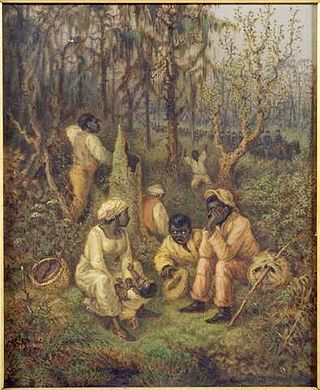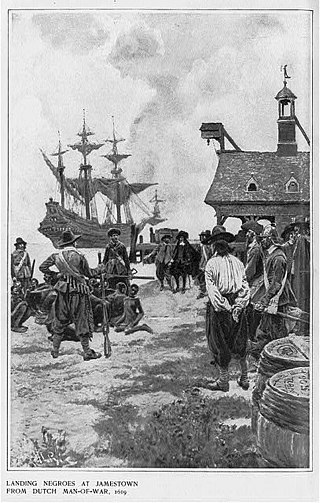
The Atlantic slave trade or transatlantic slave trade involved the transportation by slave traders of enslaved African people, mainly to the Americas. The outfitted European slave ships of the slave trade regularly used the triangular trade route and its Middle Passage, and existed from the 16th to the 19th centuries. The vast majority of those who were transported in the transatlantic slave trade were from Central and West Africa who had been sold by West African slave traders mainly to Portuguese, British, Spanish, Dutch, and French slave traders, while others had been captured directly by the slave traders in coastal raids; European slave traders gathered and imprisoned the enslaved at forts on the African coast and then brought them to the Americas. Except for the Portuguese, European slave traders generally did not participate in the raids because life expectancy for Europeans in sub-Saharan Africa was less than one year during the period of the slave trade.

Slavery in the colonial history of the United States refers to the institution of slavery as it existed in the European colonies which eventually became part of the United States. In these colonies, slavery developed due to a combination of factors, primarily the labour demands for establishing and maintaining European colonies, which had resulted in the Atlantic slave trade. Slavery existed in every European colony in the Americas during the early modern period, and both Africans and indigenous peoples were victims of enslavement by European colonizers during the era.

Partus sequitur ventrem was a legal doctrine passed in colonial Virginia in 1662 and other English crown colonies in the Americas which defined the legal status of children born there; the doctrine mandated that children of slave mothers would inherit the legal status of their mothers. As such, children of enslaved women would be born into slavery. The legal doctrine of partus sequitur ventrem was derived from Roman civil law, specifically the portions concerning slavery and personal property (chattels), as well as the common law of personal property; analogous legislation existed in other civilizations including Medieval Egypt in Africa and Korea in Asia.

John Casor, a servant in Northampton County in the Colony of Virginia, in 1655 became one of the first people of African descent in the Thirteen Colonies to be enslaved for life as a result of a civil suit.

Anthony Johnson was an Angolan-born man who achieved wealth in the early 17th-century Colony of Virginia. Held as an indentured servant in 1621, he earned his freedom after several years and was granted land by the colony.

Atlantic Creole is a cultural identifier of those with origins in the transatlantic settlement of the Americas via Europe and Africa.

The trafficking of enslaved Africans to what became New York began as part of the Dutch slave trade. The Dutch West India Company trafficked eleven enslaved Africans to New Amsterdam in 1626, with the first slave auction held in New Amsterdam in 1655. With the second-highest proportion of any city in the colonies, more than 42% of New York City households enslaved African people by 1703, often as domestic servants and laborers. Others worked as artisans or in shipping and various trades in the city. Enslaved Africans were also used in farming on Long Island and in the Hudson Valley, as well as the Mohawk Valley region.
Daniel Elfrith was a 17th-century English privateer, colonist and slave trader. In the service of the Earl of Warwick, Elfrith was involved in privateering expeditions against the Spanish from his base in Bermuda. He was particularly known for capturing Spanish slave ships bound for the Spanish Main and selling the slaves himself to rival colonies in the Caribbean and the American colonies.
Angolan Americans are an ethnic group of Americans of Angolan descent or Angolan immigrants. According to estimates, by the year 2000 there were 1,642 people descended from Angolan immigrants in the United States. However, the number of Angolan Americans is difficult to determine. Many African-Americans are descendants of Angolan enslaved people. In 1644, most of the 6,900 slaves bought on the African coast to clear the forests, lay roads, build houses and public buildings, and grow food came from the established stations in Angola.

Slavery among Native Americans in the United States includes slavery by and enslavement of Native Americans roughly within what is currently the United States of America.

Slavery in Virginia began with the capture and enslavement of Native Americans during the early days of the English Colony of Virginia and through the late eighteenth century. They primarily worked in tobacco fields. Africans were first brought to colonial Virginia in 1619, when 20 Africans from present-day Angola arrived in Virginia aboard the ship The White Lion.

The Great Dismal Swamp maroons were people who inhabited the swamplands of the Great Dismal Swamp in Virginia and North Carolina after escaping enslavement. Although conditions were harsh, research suggests that thousands lived there between about 1700 and the 1860s. Harriet Beecher Stowe told the maroon people's story in her 1856 novel Dred: A Tale of the Great Dismal Swamp. The most significant research on the settlements began in 2002 with a project by Dan Sayers of American University.
John Punch was an enslaved African who lived in the colony of Virginia. Thought to have been an indentured servant, Punch attempted to escape to Maryland and was sentenced in July 1640 by the Virginia Governor's Council to serve as a slave for the remainder of his life. Two European men who ran away with him received a lighter sentence of extended indentured servitude. For this reason, some historians consider John Punch the "first official slave in the English colonies," and his case as the "first legal sanctioning of lifelong slavery in the Chesapeake." Some historians also consider this to be one of the first legal distinctions between Europeans and Africans made in the colony, and a key milestone in the development of the institution of slavery in the United States.

In May 1607, one hundred men and young boys were on an expedition where they arrived in what is now known as Virginia. This group were the first permanent English settlers in America. They named the colony of Jamestown, after the English King James. The site was chosen precisely for its location and beneficial factors. Jamestown was surrounded by water on three sides of the land; this made it easily accessible for ships to come and go. It was far enough inland, making it easier to defend from a possible Spanish attack. At the time, it was said that the men had to be able to create a living before any women could be a part of the colony.

The White Lion was an English privateer operating under a Dutch letter of marque which brought the first Africans to the English colony of Virginia in 1619, a year before the arrival of the Mayflower in New England. Though the African captives were sold as indentured servants, the event is regarded as the start of African slavery in the colonial history of the United States.
John Graweere also known as John Gowen was one of the First Africans in Virginia, who was a servant who earned enough money to pay for his son's freedom. He filed a lawsuit to free his son, arguing that he wanted to raise him as a Christian. The court agreed and freed the son.
William Tucker was born to two of the first Africans in Virginia who landed in Jamestown Colony before his birth. He was the first African American that was born in the British colonies that later became the United States.
Angela, also Angelo, was one of the first enslaved Africans to be officially recorded in the Colony of Virginia in 1619.
African Americans are the largest racial minority in Virginia. According to the 2010 Census, more than 1.5 million, or one in five Virginians is "Black or African American". African Americans were enslaved in the state. As of the 2020 U.S. Census, African Americans were 18.6% of the state's population.
Arrival of the First Africans in English America is a 2023 American documentary film written and directed by Ric Murphy in his feature directorial debut, based on his 2020 book of the same name. The film was shown on the festival circuit, culminating in its United States premiere at the American Theatre in Hampton, Virginia on August 26, 2023.












